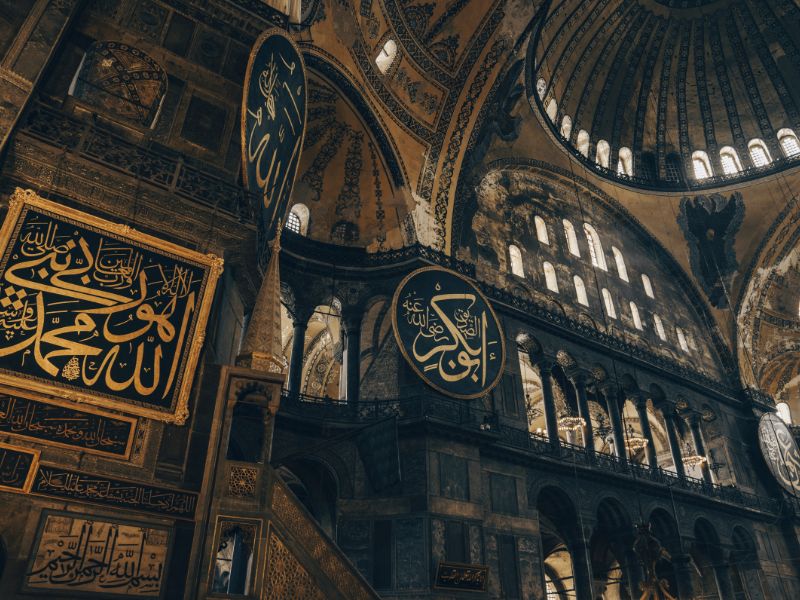Table of Contents
Hagia Sophia and Theodora
The story of Hagia Sophia and Theodora is not just about architecture or imperial grandeur—it’s about resilience, vision, and a woman who altered the course of history. While Emperor Justinian I is credited with building Hagia Sophia, it was Empress Theodora’s courage and leadership during the Nika Revolt of 532 AD that made its construction possible.
Her defiance in the face of revolt, her political skill, and her religious convictions not only preserved the empire but ensured that Hagia Sophia would rise from the ashes as a beacon of power and faith.
From the Arena to the Throne: Theodora’s Remarkable Rise

Born into modest circumstances around 500 AD, Theodora’s early life was anything but regal. Her father was a bear keeper at the Hippodrome, and after his death, she turned to acting and performing—professions scorned in Byzantine society. Yet her intellect and strength of character stood out. When she met Justinian, then heir to the throne, he was so captivated that he had laws changed to marry her.
In 527 AD, she was crowned Augusta. But Theodora was not content to play a ceremonial role. She became an equal partner in power, participating in political decisions, advocating for women’s rights, and influencing foreign and religious policies. Her sharp mind and unwavering presence in court made her one of the most formidable figures of her time.
The Nika Revolt: A Crisis That Gave Birth to a Monument

A City in Flames, A Church in Ruins
By 532 AD, Constantinople was teetering on the edge. High taxes and government corruption had fueled discontent. When two rival factions—the Blues and the Greens—united in protest, the unrest exploded into the Nika Revolt. Rioters torched the city, including the original Hagia Sophia, and even proclaimed a new emperor.
Amid the chaos, Justinian prepared to flee. But Theodora stood firm. In a speech that would echo through history, she declared, “Royalty is a fine burial shroud,” urging him to fight rather than flee. Shamed and emboldened, Justinian ordered the army to strike. Over 30,000 rioters were killed in the Hippodrome, the rebellion was crushed, and the empire stood—because Theodora had not faltered.
Theodora’s Indirect Role in Rebuilding Hagia Sophia
With the old church destroyed, Justinian seized the moment to build a new and greater one. But it was Theodora’s resolve that made this possible. Without her intervention, there may have been no emperor to commission Hagia Sophia. Her presence shaped not only the survival of the empire but the birth of its most enduring symbol.
Architectural Glory and Religious Diplomacy
A New Church Rises
Together with Justinian, Theodora oversaw the planning of a church unlike any before. Anthemius of Tralles and Isidore of Miletus designed Hagia Sophia with revolutionary engineering: a massive dome soaring 55.6 meters above the floor, supported by pendentives that allowed it to float above a square base. Forty windows bathed the interior in light, making the dome appear suspended in the heavens.
Theodora supported this vision wholeheartedly, understanding that Hagia Sophia would not only restore faith after the revolt, but also assert Byzantine strength to the world.
Champion of Religious Minorities
While Justinian enforced Orthodoxy, Theodora quietly championed the Miaphysite Christians, a sect often persecuted by the state. She sheltered clergy in the palace, appointed sympathetic bishops, and ensured theological diversity endured within the empire. Hagia Sophia, under her influence, became not just a political symbol but a space that reflected the empire’s religious complexity.
Theodora’s Death and Enduring Legacy

Theodora died in 548 AD, yet her legacy endured. Her mosaic in the Basilica of San Vitale in Ravenna remains one of the most striking depictions of imperial power, even if she was never officially represented in Hagia Sophia. The church’s very existence, however, is her true monument.
She was the mind behind the moment Justinian found his resolve. She was the reason the empire stood long enough to build what would become the jewel of Byzantium. And though she passed away just over a decade after the church’s dedication, the story of Hagia Sophia and Theodora is inseparable.
Conclusion
Hagia Sophia and Theodora are bound by more than time—they are linked by vision and defiance. Theodora’s courage during the Nika Revolt saved an emperor and an empire. Her support of Hagia Sophia’s construction and her influence on religious policy ensured the monument would stand not only as a feat of engineering but as a symbol of survival and faith.
Behind Justinian’s towering dome is the legacy of an empress who refused to flee, who rewrote the rules of her world, and who left her mark not in marble or gold, but in the endurance of a civilization’s most sacred space.






